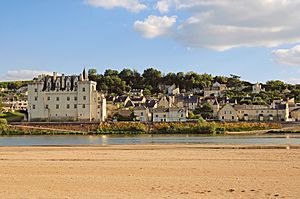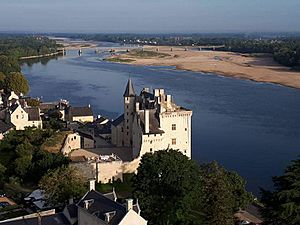Château de Montsoreau facts for kids
Quick facts for kids Château de Montsoreau |
|
|---|---|

Château de Montsoreau, Loire Valley.
|
|
| General information | |
| Architectural style | Flamboyant Gothic, French Renaissance |
| Location | Montsoreau Maine-et-Loire France |
| Address | Château de Montsoreau 49730 Montsoreau France |
| Coordinates | Lua error in Module:Coordinates at line 614: attempt to index field 'wikibase' (a nil value). |
| Current tenants | Philippe Méaille |
| Construction started | 1443 |
| Completed | 1515 |
| Height | 45m |
| Official name: The Loire Valley between Sully-sur-Loire and Chalonnes, previously inscribed as Chateau and Estate of Chambord | |
| Type: | Cultural |
| Criteria: | i, ii, vi |
| Designated: | 2000 (24th session) |
| Reference #: | 933 |
| Region: | Europe |
The Château de Montsoreau is a beautiful castle in the Loire Valley region of France. It was built right on the edge of the Loire river. You can find it in the small town of Montsoreau, in the Maine-et-Loire area of France. It's close to other famous places like Saumur and Chinon.
This castle is special because it sits where two rivers, the Loire and the Vienne, meet. It's also where three historical regions of France – Anjou, Poitou, and Touraine – come together.
People have lived in Montsoreau since ancient Roman times. While we don't know for sure if a castle was there back then, parts of an old Roman column were found during later repairs. The first written records about Montsoreau are from the 6th century. A strong fortress was built here in the late 900s, which helped the town grow. Parts of this first castle were also found by archaeologists.
The castle you see today was rebuilt in a fancy Gothic style between 1450 and 1460. This was done by Jean de Chambes, who was one of the richest men in the kingdom. He was a senior advisor to King Charles VII and King Louis XI.
The Château de Montsoreau became famous when Alexandre Dumas wrote about it in his novel La Dame de Monsoreau (1845–1846). This book is part of a series about the Renaissance period.
Parts of the Château de Montsoreau were recognized as a special historical building by the French government in 1862, 1930, and 1938. The entire Loire Valley, including Montsoreau, became a UNESCO World Heritage Site on November 30, 2000. This means it's a very important place for the world's history and culture.
In 2015, a French art collector named Philippe Méaille made a deal to use the Château de Montsoreau for 25 years. He turned it into a museum called the Château de Montsoreau-Museum of Contemporary Art. This museum shows Méaille's collection of art from a group called Art & Language, who create modern conceptual art.
Contents
What's in a Name?
The Name's Origin
The name Montsoreau first appeared in records in 1086. It was called Castrum Monte Sorello or Mons Sorello in Latin. Mons or Monte means a rocky hill or promontory. The meaning of Sorello isn't fully known, but it might mean "bald" or "red." Before the castle was built, there might have been an important building from Roman times on this spot.
A Literary Hint
In his novel La Dame de Monsoreau, Alexandre Dumas gave a hint about the castle's name:
"Mount of the mouse," Antraguet continued, "this is the etymology: my old abbot learned me this morning: Mons Soricis."
Castle History
Early Days
The first written record of this area, then called Restis, is from the 6th century. In 990, Eudes, the First Count of Blois, turned it into a fortified castle. In 1001, the Anjou region took control, and Foulques Nerra gave it to Gautier I of Montsoreau. Gautier I was from an important family in Anjou.
The Castrum Monsorelli became one of the forty fortified castles in Anjou. It was also one of the few to be called a "lordship" around the year 1000. A town quickly grew near the castle. By the mid-11th century, it was described as a very strong and populated place. Records from the 12th century show that the castle had the right to collect taxes.
When the order of Fontevraud was founded in 1101, Fontevraud Abbey was overseen by Gautier de Montsoreau. His stepmother, Hersende de Champagne, was one of the first leaders and co-founders of the Abbey.
Guillaume IV de Montsoreau supported Geoffrey Plantagenet against his brother Henri II Plantagenet, who later became King of England. King Henry II attacked the castle in 1152 and captured Guillaume and his defenders. However, Guillaume IV later got his castle back.
Later Owners
The Montsoreau family line changed over time. In 1213, the lordship passed to the Savary de Montbazon family when Gautier's daughter Ferrie married Pierre II Savary de Montbazon.
In 1450, Louis II Chabot sold the Montsoreau castle to his brother-in-law, Jean II de Chambes. Jean II de Chambes then began rebuilding the castle. He was a very important person in the court of King Charles VII. He served as an esquire, a royal advisor, and even an ambassador to Venice in 1459. His wealth and influence grew during these years.
Modern Times
From 1450 to 1460, while Jean II de Chambes was busy with his ambassador duties, the castle was being built. He was very close to King Charles VII. After 1461, he slowly stepped away from politics.
Jean III de Chambes took over after his father died in 1473. His wife, Marie de Chateaubriant, founded a church near the castle in 1519. Later, in 1530, Philippe de Chambes, who lived at Montsoreau, married Anne de Laval-Montmorency. His oldest son, Jean VI de Chambes, became the baron of the lands in 1560.
In 1568, Protestants attacked Montsoreau, destroying the church and city defenses. Four years later, Jean VI de Chambes was involved in the "Saint Bartholomew" events in Saumur and Angers. His title as Baron was confirmed in 1573 and 1575.
After Jean VI's death in 1575, his brother Charles de Chambes became Count of Montsoreau. The next year, he married Françoise de Maridor, who was connected to the murder of Louis de Bussy d'Amboise.
In the late 1500s, about seventy warriors lived in the castle. This stopped during the reign of Louis XIII. One owner, René de Chambes, was accused of counterfeiting and had to flee to England, never returning. After his successor, Bernard de Chambes, died, the castle was rarely used by its owners.
Recent History
The castle was sold after 1804. Over the years, 19 different owners lived there, changing the building. By 1910, the château was in bad shape. The French Archaeological Society became concerned. The local government began buying parts of the property after 1913. Restoration work started in 1923 and continued until Second World War.
After more restoration work between 1997 and 2001, the château opened to visitors on July 6, 2001. It featured a "sound and light" show called "The Imaginaries of Loire," which attracted about 35,000 visitors each year.
In June 2015, the local council leased the Château to Philippe Méaille. He created the Château de Montsoreau-Museum of Contemporary Art, which opened in April 2016. The museum displays artworks by the Art & Language group and hosts special exhibitions and talks.
Location and Natural Beauty
Where the Castle Stands
The Château de Montsoreau is located where the Loire and Vienne rivers meet. It's also at the point where three historical regions – Anjou, Poitou, and Touraine – come together. The castle is part of a protected area called the Loire-Anjou-Touraine Regional Nature Park.
The castle was built right into the bed of the Loire River, at the bottom of a hillside. The local stone, called tufa, is still visible in many places. Many houses in the area are built from this stone, and some are even built into the hillsides or caves. The castle's location was considered very strong for defense, as it sits between two small valleys on a high area with steep slopes.
Castle Design
Building Features
Jean II de Chambes built the Château de Montsoreau in 1455. This building shows a change from castles built mainly for war to those built for comfort and enjoyment. You can see this in its large windows, many chimneys, and good sanitation systems. The main part of the castle was built directly on the riverbanks.
Unusually, two wings were added a few years later. These wings look like square towers framing the main building. This was unusual because round towers were more common at the time. This design actually hinted at the corner pavilions seen in later classical architecture. There was likely a spiral staircase before the current Renaissance staircase was built.
The ground floor and cellars facing the courtyard allowed control of river traffic on the Loire. One room even has direct access to the river. The main staircase leads to the ground floor living area and the first-floor salon. This very bright room is lit by five windows and is seventeen meters long. It has two large fireplaces to keep it warm.
Smaller rooms around the main living area show the shift between public and private spaces. In 1473, Jean III de Chambes added a Renaissance staircase tower. This tower has a unique polygonal shape and a terrace on top. The steps lead to a beautiful, palm-tree-shaped ceiling, similar to those in other famous buildings in Angers and Saumur. The stairs are decorated with pilasters, medallions, and figures of small children (putti).
A central panel on the staircase shows a helmet with the family's motto, "Chambe Crie." Above this, two monkeys hold a chain. The chain is attached to a belt with the words "Je le feray" (I will do it). Another panel shows trees and branches, with a deer in front, symbolizing hunting.
The Château de Montsoreau in Art
Paintings and Drawings
Joseph Mallord William Turner
In October 1826, William Turner, a famous artist, visited the Loire river. He made many sketches of the river, including the Château de Montsoreau. This watercolor painting is now kept at the Ashmolean Museum in Oxford. An engraving of it was made in 1832, and a copy is at the Château de Montsoreau – Museum of Contemporary Art.
Auguste Rodin
Auguste Rodin, a famous sculptor, was fascinated by the architecture of the Château de Montsoreau. Around 1897, he drew an idealized view of its north side.
Paul-Désiré Trouillebert
Paul-Désiré Trouillebert, a painter from the Barbizon school, worked in Paris and Candes-Saint-Martin. He painted several landscapes of the Loire river that feature the Château de Montsoreau.
Popular Culture
In 2019, the English magazine All About History listed its "101 World's Greatest Castles." The Château de Montsoreau was ranked at number 53 on this list.
See also
 In Spanish: Castillo de Montsoreau para niños
In Spanish: Castillo de Montsoreau para niños
- Châteaux of the Loire Valley
- List of castles in France






